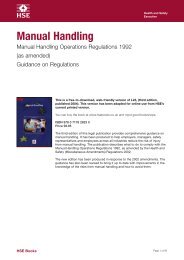Making Companies Safe - what works? (CCA ... - Unite the Union
Making Companies Safe - what works? (CCA ... - Unite the Union
Making Companies Safe - what works? (CCA ... - Unite the Union
You also want an ePaper? Increase the reach of your titles
YUMPU automatically turns print PDFs into web optimized ePapers that Google loves.
warning, suspension and finally dismissal. 27 This belief that incidents are caused by <strong>the</strong> unsafe<br />
acts of workers, and <strong>the</strong> existence of punitive internal systems are also predominant features<br />
of specific safety management systems (see below). In addition, <strong>the</strong> AFL-CIO have found that<br />
some companies participating in <strong>the</strong> Maine 200 program achieved reductions in <strong>the</strong>ir injury<br />
rates by shutting down departments within <strong>the</strong> organisation that had <strong>the</strong> highest injury rates<br />
and contracting <strong>the</strong>ir work out to o<strong>the</strong>r companies. 28<br />
In conclusion, while <strong>the</strong> HSE’s proposals for ‘earned autonomy’ are modelled on OSHA’s<br />
incentive-based programs and put forward on <strong>the</strong> basis of similar budgetary arguments, 29 no<br />
adequate systematic evaluation of <strong>the</strong>se programs exists. 30 Moreover, <strong>the</strong> evidence that does<br />
exist is conflicting as regards <strong>the</strong> impacts of <strong>the</strong>se programs on workers’ health and safety and<br />
suggests that <strong>the</strong>re may be inherent problems in monitoring and evaluating outcomes. This<br />
is because narrow performance indicators, such as lost time injuries, are not necessarily<br />
accurate indicators of an organisation’s health and safety performance, and also because<br />
o<strong>the</strong>r outcome data – such as <strong>the</strong> number and severity of hazards identified and corrected –<br />
is reported by <strong>the</strong> individual organisation itself and may not be verifiable. Potential difficulties<br />
with <strong>the</strong> auditing and evaluation of ‘earned autonomy’, as well as more general questions<br />
concerning <strong>the</strong> regulation of such a scheme, will be discussed fur<strong>the</strong>r below. However, first<br />
we will consider <strong>the</strong> more general empirical evidence that exists in relation to <strong>the</strong> impact of<br />
systems-based approaches to OHS management and whe<strong>the</strong>r <strong>the</strong>se have <strong>the</strong> potential to<br />
create genuinely self-regulating organisations.<br />
Evidence Concerning <strong>the</strong> Impact of Systems-Based<br />
Approaches<br />
Since one of <strong>the</strong> conditions for achieving ‘earned autonomy’ status might be that<br />
organisations have adopted a safety management system that conforms to some specified<br />
standard, it is important to consider:<br />
• First, whe<strong>the</strong>r <strong>the</strong>re is evidence that having a SMS does actually bring about<br />
improvements in OHS outcomes – namely reduced rates of injury, disease and death.<br />
• And second, whe<strong>the</strong>r <strong>the</strong>re is evidence that introduction of a SMS stimulates a sufficient<br />
level of self-regulation and improvement to justify <strong>the</strong> withdrawal or diminishing of<br />
regulatory intervention.<br />
The Development of <strong>Safe</strong>ty Management Systems (SMSs)<br />
The development of specific OHS management systems (or SMSs) is based on <strong>the</strong> notion that<br />
<strong>the</strong> systematic and proactive management of OHS is more likely to bring about improvements<br />
to health and safety than reactive, ad hoc measures to address specific hazards:<br />
“Employers are being asked to move from policies that were often little more than<br />
ad hoc solutions to an array of known hazards to a more articulated set of<br />
structures and procedures for identifying, assessing, and controlling OHS risks.” 31<br />
Saksvik and Quinlan note that <strong>the</strong> terms ‘systematic occupational health and safety<br />
management’ (SOHSM) and ‘occupational health and safety management systems’ (or SMSs)<br />
are often confused, but that formal OHS management systems are:<br />
“best viewed as a wide array of programmatic measures employers may adopt<br />
voluntarily or in an effort to meet SOHSM requirements.” 32<br />
The development of formal SMSs is also a product of <strong>the</strong> development within management<br />
<strong>the</strong>ory and practice of a systems approach to product quality and <strong>the</strong> related concepts of<br />
‘quality assurance’ (QA) and ‘total quality management’ (TQM). 33 TQM, as defined by <strong>the</strong><br />
European Foundation for Quality Management, is:<br />
86<br />
“The way <strong>the</strong> organisation is managed to achieve business excellence based<br />
upon fundamental principles, which will include: customer focus, involvement<br />
and empowerment of people and teams, business process management and<br />
prevention based systems, continuous improvement.” 34
















